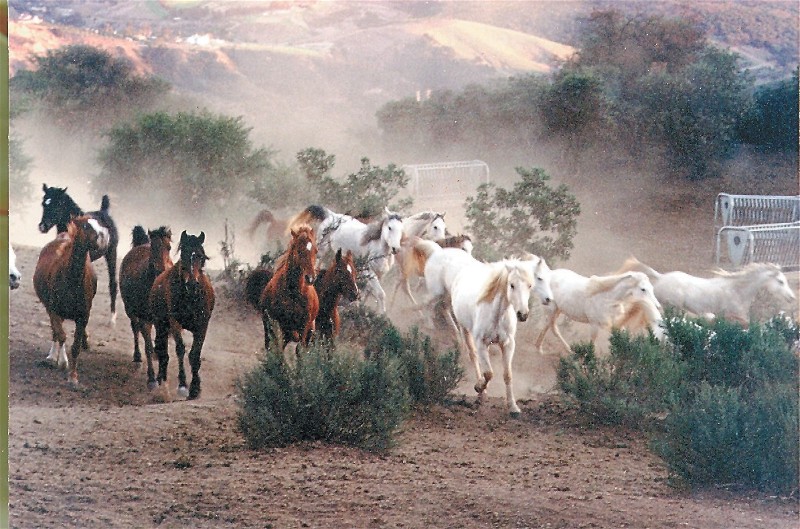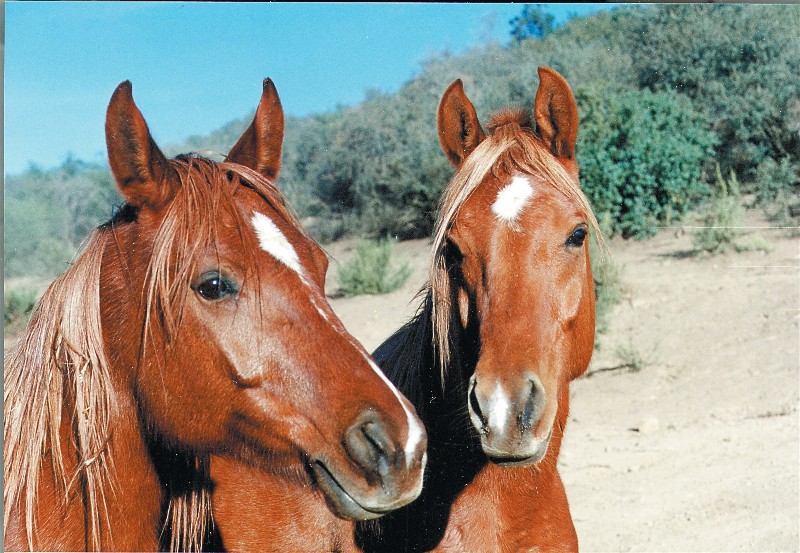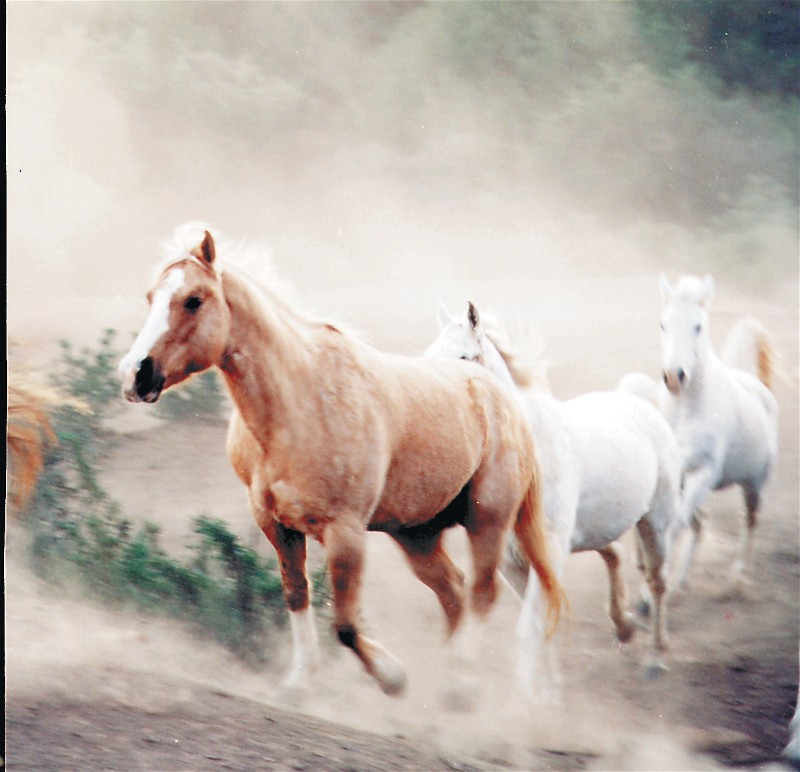First the sound of thundering hoof beats. Then a cloud of dust rises over the hilltop like an ancient smoke signal to herald their coming. Their faces emerge, angled in a uniform direction, filled with intention and singular purpose. Manes fly, backlit in gold by the late afternoon sun. Legs stretch and curl, a delicate contrast to the massive bodies of rippling muscles. In a heart beat they have passed. Dust clouds fold over them as they disappear, yet even the earth itself seems to lie panting in their wake.
 The opportunity to watch the fantastic spectacle of a herd of horses galloping free is one that is not to be missed. The image holds an archetypal power for the human psyche, representing strength tempered by grace and beauty, freedom directed into a common cause, and the process whereby the many are united as one. A single horse in motion can be a magnificent and often breathtaking image, but when horses move in a herd the impact is multiplied. Often the galloping herd appears to have no individual leader. Instead the herd itself seems to have its own mind and a life and identity of its own. The herd moves in and of itself, aimed at clear and purposeful objectives, going toward an invisible destination with all the heart and fervor of the greatest athlete. The opportunity to watch the fantastic spectacle of a herd of horses galloping free is one that is not to be missed. The image holds an archetypal power for the human psyche, representing strength tempered by grace and beauty, freedom directed into a common cause, and the process whereby the many are united as one. A single horse in motion can be a magnificent and often breathtaking image, but when horses move in a herd the impact is multiplied. Often the galloping herd appears to have no individual leader. Instead the herd itself seems to have its own mind and a life and identity of its own. The herd moves in and of itself, aimed at clear and purposeful objectives, going toward an invisible destination with all the heart and fervor of the greatest athlete.
Far too few horse ranches in today’s world have set up an area that allows for herd life on the ranch. The logistics of setting up herd living space on smaller ranches can be a challenge, but like many challenges it has its rewards, not the least of which is the opportunity to watch the horses galloping free from time to time.
Horses are highly social beings, and when living in herds, they form strong bonds and ties. In today’s world, most horses live their entire life in barns or paddocks, and their association with other horses consists of fence talk with the neighboring horse on either side.  Or the horse lives completely alone, and his social encounters with other horses are the moments when he, under saddle, joins other mounted horses in an arena or on a trail ride. Horses in training are typically kept in small “handy to catch” areas, and show horses are often kept clipped and blanketed, and fed a controlled diet. Or the horse lives completely alone, and his social encounters with other horses are the moments when he, under saddle, joins other mounted horses in an arena or on a trail ride. Horses in training are typically kept in small “handy to catch” areas, and show horses are often kept clipped and blanketed, and fed a controlled diet.
Some ranch owners believe that would be difficult to have a training and breeding program, and a herd situation at the same time. But we’ve learned that not only is it possible to have both, but also that one can compliment the other. Herd life advocates say that saddle horses who get a certain amount of time in a herd area are calmer and more balanced under saddle, that learning how to get along with other horses gives the horse more self-confidence and makes the horse easier to train. Horses with access to herd life are sure to be happier and better adjusted, all of which leads to greater health and well being.
The photos shown here were taken at a ranch where herd life for horses is esteemed as an essential aspect of good health and well being for horses. The ranch is only a little over 140 acres in size, but it has been set up to foster both herd life and an extensive riding, training, and breeding program. Barns, paddocks, and riding arenas are located on one end of the ranch. Stallions are housed in pastures near the barn, and each lives with a companion. The herd area of open space along with trails is set up on another part of the ranch.
The herd area has held as many as 40 horses – mares, geldings, and yearlings. Horses are regularly moved in and out of the herd for various purposes which include working, riding and training them, doctoring them, and breeding and foaling. In the herd area the horses are free to roam and graze, but the actual feeding is done in large feeders situated in one part of the herd area, The location of the feeders becomes a gathering place at feeding time, and this makes it easy to halter a horse who may need special care, or who may need to be moved to the training area.
 Activities around the feeders reveal which horses are dominant over which other horses, and where the alliances lie. Dominance is ever-changing with horses continually moving in and out of the herd, and the horses are pretty much left to their own devices to work these things out. Activities around the feeders reveal which horses are dominant over which other horses, and where the alliances lie. Dominance is ever-changing with horses continually moving in and out of the herd, and the horses are pretty much left to their own devices to work these things out.
Horses can form extremely strong relationships with one another. We heard some great stories from the ranch managers. One was of rather comical couple -- Andy, an older black quarter horse gelding, and Kenora, a flouncy Clydesdale mare. We were told that Andy was normally the herd leader, but he would go quiet as a church mouse in the presence of the overbearing Kenora, making it quite clear who wears the pants in the family! Then we heard about the hot new relationship going on between a young chestnut Arabian gelding named Aziri and a chestnut Arabian mare more than twice his age named Dawn. Dawn had previously paired herself up with another chestnut Arabian named Blue until Aziri won her heart and left Blue blue. But not for long - Blue found new romance with one of the prettier bay mares. And so the stories go on and on, and somehow our human dramas seem no more or no less significant. How arrogant that I would think otherwise!
Perhaps the most touching story was the one about Charlie, a Palomino Belgian draft horse who was the oldest member of the herd. One day he fell. He had cracked his hip and could not get up but it took some time for the vet to arrive and make the diagnosis. When it became clear that Charlie would not get up again and that he would have to be put down, the herd came up as a group and circled the spot where Charlie was lying as if they had gathered to say good-bye to Charlie and to pay tribute to him. I could image the silent group approaching the spot where Charlie lay, standing for a brief moment, and then slowly and calmly departing, effortlessly allowing the course of life to take its turn.
Horses that live in herds are living a life that is natural to a horse, because horses are herd animals by nature. Herd life can also bring treasured moments to the horse owner, as well as the satisfaction of knowing that one has provided an optimum situation for one’s horses. If you own a ranch now but you don’t have a herd area, you may find that setting up a herd area is easier than you had thought it would be. And if you’re planning to buy a ranch, you may wish to consider where you would put your herd area as you look at possibilities. Keep in mind that a gathering place with feeders can make it easy to take inventory of your herd each day, and to move horses in and out of the herd. Also you might explore various types of shelter that can easily be erected in herd areas. If you have tips for creating and maintaining herd life on your ranch, please email them to info@RanchAndCountry.com, and we will publish them here.
The vision of the herd at full gallop is at the very least a symbol, but perhaps more accurately, an embodiment of a process whereby individuals freely choose to participate in and align with a unifying action. When the horses run together across the land as a herd they express the delicate interplay between individual freedom and the unity of spirit, and they bless the land just by being.
|